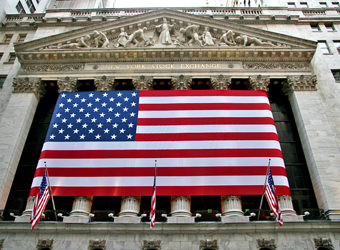The Dow Jones industrial average rebounded more than 300 points Friday, paring deep losses for investors in what still amounted to the worst week in two years.
The Dow ended the day up 330.44 points, or 1.38 percent, closing at 24,190.90. The S&P 500 rallied 1.49 percent to finish at 2,619.55, while the Nasdaq composite added 1.44 percent to close at 6,874.49. The index swung more than 1,000 points in volatile trading Friday.
The Dow and the S&P 500 both lost 5.2 percent on the week, while the Nasdaq shed 5.1 percent as rising interest rates spooked investors.
The Dow average experienced two drops of more than 1,000 points and two gains of more than 300 points during this volatile week. At their lows this week, all three major indexes were in correction territory from the record highs reached in January.
“What’s happened here is an understanding that inflation is returning and that the central bank quantitative easing that we’ve grown accustomed to is coming to an end,” said Jim Bianco, head of the Chicago-based advisory firm Bianco Research. “Since the financial crisis, this is the first 10 percent correction in stocks that has not been accompanied by a significant fall in rates.” The Dow dropped 1,032 points Thursday and the aveage posted its worst point drop in history on Monday, closing 1,175 points lower. Monday’s decline of 4.62 percent was also its worst daily percentage drop since Aug. 10, 2011, when it also fell 4.62 percent.
The Dow dropped 1,032 points Thursday and the aveage posted its worst point drop in history on Monday, closing 1,175 points lower. Monday’s decline of 4.62 percent was also its worst daily percentage drop since Aug. 10, 2011, when it also fell 4.62 percent.
The recent turmoil in equities began last Friday, when the Dow fell 666 points after a better-than-expected jobs report ignited inflation fears.
That fall was exacerbated Monday after the yield on the benchmark 10-year Treasury note hit a 4-year high, sending the Dow tumbling another 1,175 points as investors grew more nervous about an overheating economy.
Trouble with securities called exchange-traded notes that decline in value when volatility increases likely helped create more turmoil in the markets this week. The Cboe Volatility index (VIX)— the market’s best fear gauge— shot above 40 again Friday after jumping as high as 50 earlier in the week. At the end of January, the VIX was below 14.
Yields backed off their multi-year highs on Tuesday, giving the Dow a 560-point bounce and relative stability on Wednesday. But between another round of strong economic news, hawkish comments from the Bank of England and an expensive government funding bill, yields rallied again, sparking Thursday’s sell-off.
The 10-year Treasury ticked up to 2.85 percent Friday. The note yield flirted with 2.885 percent Thursday, a 4-year high that sparked major equity sell-offs earlier in the week.
E-commerce giant Amazon wasn’t helping things either Friday. The company is gearing up to launch a delivery service for businesses, pitting Jeff Bezos’ logistical prowess against carriers like FedEx and UPS, the Wall Street Journal reported early in the day.
Shares of UPS and FedEx both closed down Friday, down 2.6 percent and 1.7 percent respectively; Amazon also fell, down 0.8 percent.
Other stocks that have struggled this week include 3M, American Express and Exxon Mobil. Exxon finished the week down more than 10 percent as oil prices continue to slide.
Crude prices fell for a sixth day on Friday, posting their worst weekly decline in two years. U.S. West Texas Intermediate (WTI) crude settled at $59.20, down 3.2 percent.
Overseas markets fell Friday. In Japan, the Nikkei 225 index fell 2.3 percent, now down 11.4 percent from its 52-week high. In Germany, the Dax index slipped 1.25 percent, down nearly 11 percent from its own 52-week high.
While the week certainly spooked many traders, several Wall Street strategists believe the recent volatility shouldn’t affect the rest of 2018.
“When the nervousness hit, a lot of people who were thinking of quitting hit the exits,” said Bruce McCain, chief investment strategist at Key Private Bank. “A lot of people want to let it settle out a bit and really make sure the worst has past … [but] for our standpoint on where we’ll be over the next year: We see no signs of recession.”
Progress on a government spending bill also made headlines on the week’s final day of trading. President Donald Trump signed a massive spending deal into law after both chambers of Congress approved the bill early Friday morning.
Source: CNBC
